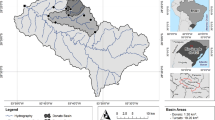Abstract
The assessment of uncertainty prediction has become a necessity for most modeling studies within the hydrology community. This paper addresses uncertainty analysis on a novel hybrid double feedforward neural network (HDFNN) model for generating the sediment load prediction interval (PI). By using the Lower Upper Bound Estimation (LUBE) method, the lower and upper bounds are directly generated as outputs of neural network based models. Coverage Width-based Criterion (CWC) is employed as an objective function for searching high quality PIs. The LUBE-based model is then applied to estimate sediment loads of Muddy Creek in Montana of USA. Results demonstrate the suitability of HDFNN-LUBE model in producing PI in both 90% and 95% confidence levels (CL). It is capable of generating appropriate lower bounds of PIs with narrow intervals. Partitioning analysis reveals consistently excellent performances of HDFNN model in constructing PI in terms of low, medium and high loads. These results therefore verify the reliability and potentiality of the HDFNN model for sediment load estimation with uncertainty. LUBE shows its efficiency in uncertainty prediction as well, which could be used to quantify total uncertainty of data-driven models.




Similar content being viewed by others
References
Alvisi S, Creaco E, Franchini M (2012) Crisp discharge forecasts and grey uncertainty bands using data-driven models. Hydrol Res 43(5):589
Alvisi S, Franchini M (2011) Fuzzy neural networks for water level and discharge forecasting with uncertainty. Environ Model Softw 26(4):523–537
Browning LS, Bauder JW, Hershberger KE, Sessoms H (2005) Irrigation return flow sourcing of sediment and flow augmentation in receiving streams: a case study. J Soil Water Conserv 60(3):134–141
Chen XY, Chau KW (2016) A hybrid double feedforward neural network for suspended sediment load estimation. Water Resour Manag 30(7):2179–2194
Cheng CT, Chau KW (2002) Three-person multi-objective conflict decision in reservoir flood control. Eur J Oper Res 142(3):625–631
He MY (1993) Theory, application and related problems of double parallel feedforward neural networks. Xidian University, Xi'an
Khosravi A, Nahavandi S, Creighton D (2011a) Prediction interval construction and optimization for adaptive neurofuzzy inference systems. IEEE Trans Fuzzy Syst 19(5):983–988
Khosravi A, Nahavandi S, Creighton D, Atiya AF (2011b) Lower upper bound estimation method for construction of neural network-based prediction intervals. Neural Netw IEEE Trans 22(3):337–346
Kisi Ö, Fedakar Hİ (2014) Modeling of suspended sediment concentration carried in natural streams using fuzzy genetic approach. Computational Intelligence Techniques in Earth and Environmental Sciences (pp 175–196): Springer
Krzysztofowicz R (1999) Bayesian theory of probabilistic forecasting via deterministic hydrologic model. Water Resour Res 35(9):2739–2750
Kuczera G, Parent E (1998) Monte Carlo assessment of parameter uncertainty in conceptual catchment models: the Metropolis algorithm. J Hydrol 211(1):69–85
Li YT, Gu RR (2003) Modeling flow and sediment transport in a river system using an artificial neural network. Environ Manag 31(1):122–134
Mantovan P, Todini E (2006) Hydrological forecasting uncertainty assessment: incoherence of the GLUE methodology. J Hydrol 330(1):368–381
Maskey S, Guinot V, Price RK (2004) Treatment of precipitation uncertainty in rainfall-runoff modelling: a fuzzy set approach. Adv Water Resour 27(9):889–898
Montanari A (2007) What do we mean by ‘uncertainty’? The need for a consistent wording about uncertainty assessment in hydrology. Hydrol Process 21(6):841–845
Montanari A, Grossi G (2008) Estimating the uncertainty of hydrological forecasts: a statistical approach. Water Resour Res 44(12)
Pianosi F, Lal Shrestha D, Solomatine D (2010) Uncertainty analysis of an inflow forecasting model: extension of the UNEEC machine learning-based method. EGU General Assembly Conference Abstracts
Qiu L, Chen SY, Nie XT (1998) A forecast model of fuzzy recognition neural networks and its application. Adv Water Sci 9(3):258–264
Quan H, Srinivasan D, Khosravi A (2014) Particle swarm optimization for construction of neural network-based prediction intervals. Neurocomputing 127:172–180
Rocca P, Oliveri G, Massa A (2011) Differential evolution as applied to electromagnetics. Antennas Propag Mag IEEE 53(1):38–49
Shrestha DL, Solomatine DP (2006) Machine learning approaches for estimation of prediction interval for the model output. Neural Netw 19(2):225–235
Solomatine DP, Shrestha DL (2009) A novel method to estimate model uncertainty using machine learning techniques. Water Resour Res 45(12)
Storn R, Price K (1995) Differential evolution-a simple and efficient adaptive scheme for global optimization over continuous spaces. International Computer Science Institute, Berkeley
Taormina R, Chau KW (2015) ANN-based interval forecasting of streamflow discharges using the LUBE method and MOFIPS. Eng Appl Artif Intell 45:429–440
Thirumalaiah K, Deo MC (1998) River stage forecasting using artificial neural networks. J Hydrol Eng 3(1):26–32
Wang YH, Wang H, Lei XH, Jiang YZ, Song XS (2011) Flood simulation using parallel genetic algorithm integrated wavelet neural networks. Neurocomputing 74(17):2734–2744
Yang RF, Ding J, Liu GD (1998) Preliminary study of hydrology-based artificial neural network. J Hydraulics 8:23–27
Ye L, Zhou J, Gupta HV, Zhang H, Zeng X, Chen L (2016) Efficient estimation of flood forecast prediction intervals via single- and multi-objective versions of the LUBE method. Hydrol Process 30(15):2703–2716
Zhong SS, Ding G (2005) Research on double parallel feedforward process neural networks and its application. Control Decis 20(7):764–768
Zou R, Lung WS, Guo HC (2002) Neural network embedded Monte Carlo approach for water quality modeling under input information uncertainty. J Comput Civ Eng 16(2):135–142
Acknowledgements
This research was supported by Central Research Grant of Hong Kong Polytechnic University (4-ZZAD).
Author information
Authors and Affiliations
Corresponding author
Additional information
Publisher’s Note
Springer Nature remains neutral with regard to jurisdictional claims in published maps and institutional affiliations.
Rights and permissions
About this article
Cite this article
Chen, XY., Chau, KW. Uncertainty Analysis on Hybrid Double Feedforward Neural Network Model for Sediment Load Estimation with LUBE Method. Water Resour Manage 33, 3563–3577 (2019). https://doi.org/10.1007/s11269-019-02318-4
Received:
Accepted:
Published:
Issue Date:
DOI: https://doi.org/10.1007/s11269-019-02318-4




